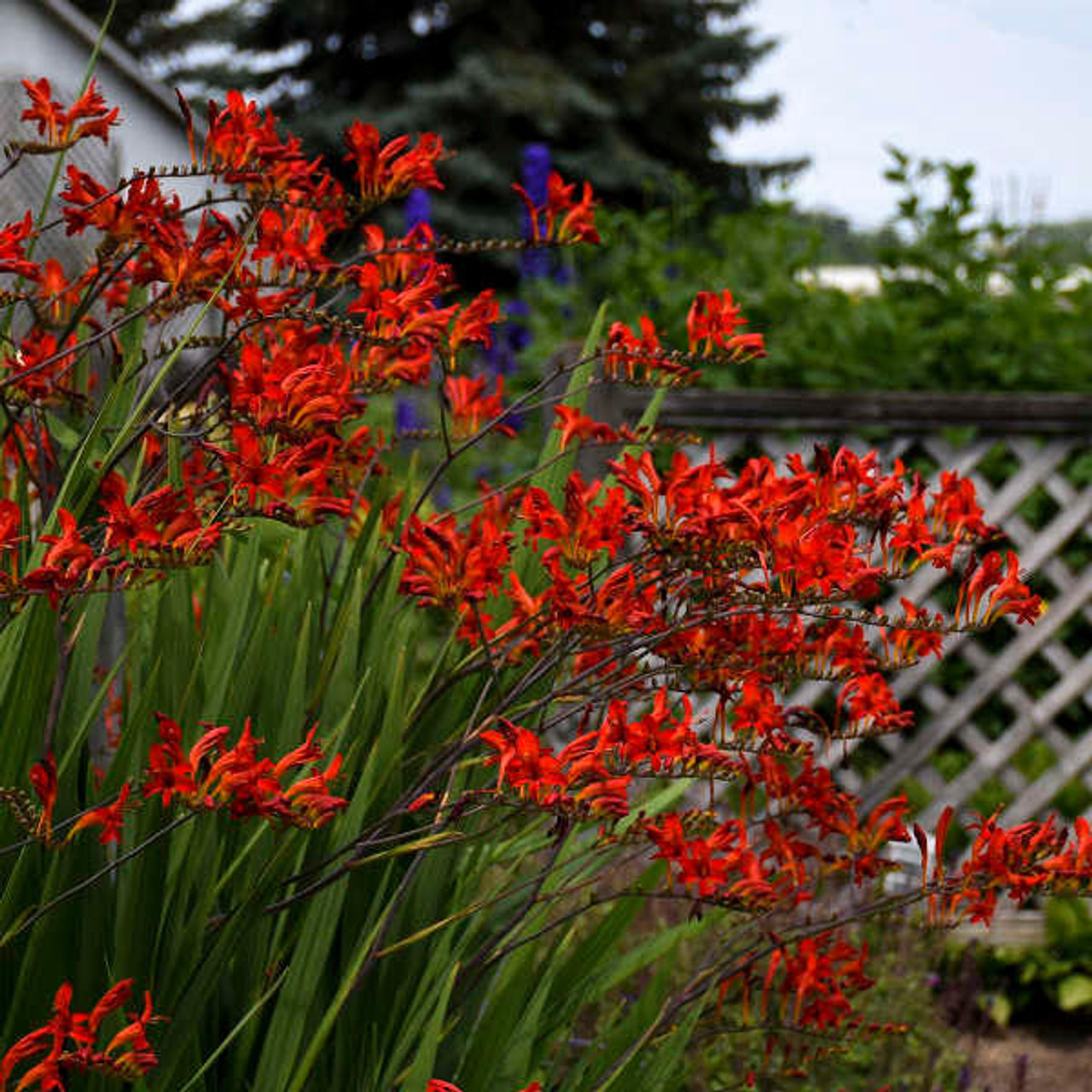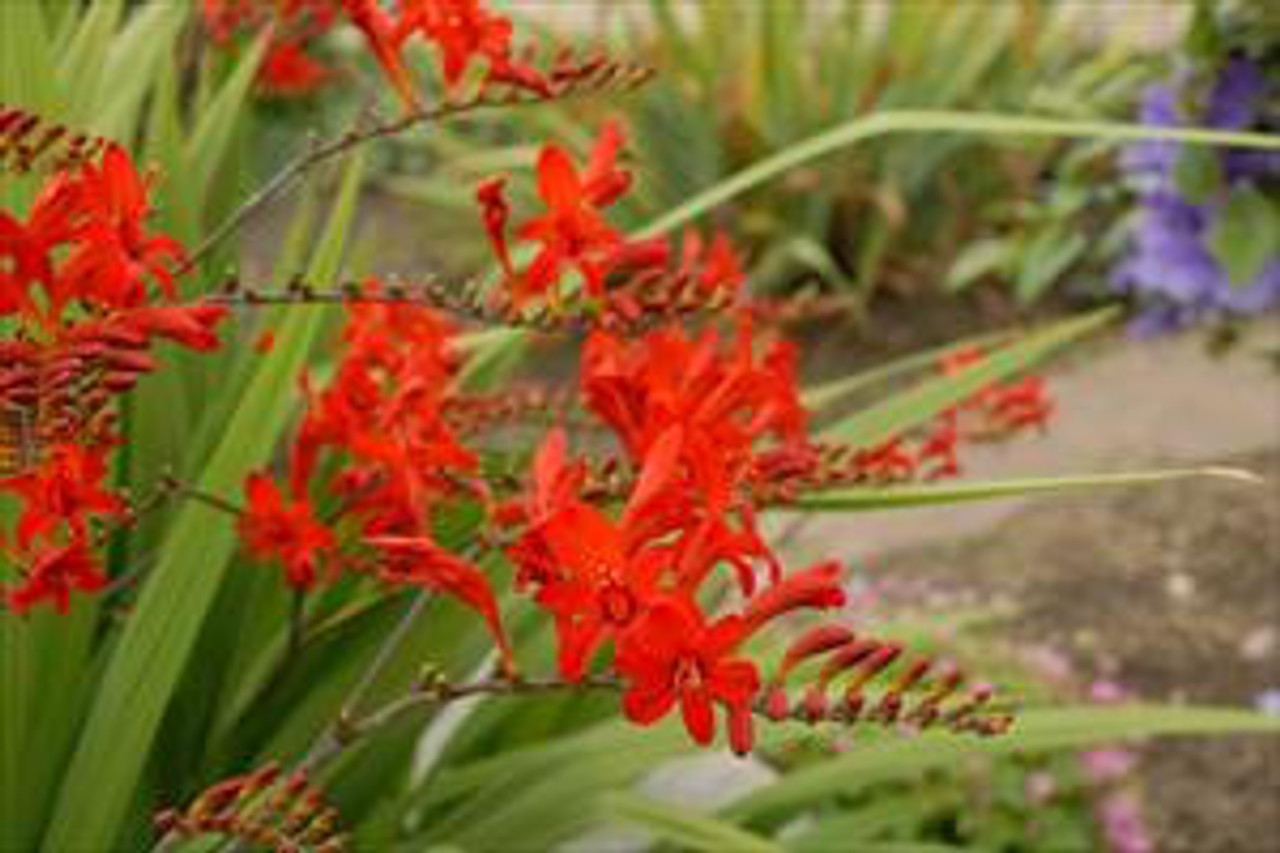Product Description
Crocosmia 'Lucifer' (25) Bare Root Corms
Common Name: Montbretia
Regarded as one of the hardiest cultivars, 'Lucifer' adds a tropical flair to northern gardens. Beginning in midsummer and continuing into early fall in some climates, brilliant flame red flowers stand in rows on wiry, gracefully arched stems that are perfect for cutting.
Crocosmia's broad, sword-like leaves are attractive even when the plants are not in bloom and, from a design standpoint, are effective for adding a spiky textured element to the landscape.
Plant Crocosmia in full sun and well-drained soil that does not become waterlogged. Its fleshy roots (corms) should be planted 2-4" deep and 6-8" apart.
Crocosmia will quickly grow and overcrowd itself, and therefore should be divided every 2-3 years. Alternatively, offsets of the original plant may be lifted and moved. In zones 1-4, corms should be lifted and stored indoors over the winter, much like cannas or dahlias. In zones 5-7, a deep winter mulch will help to protect the roots and increase the plant's chances of survival.
Royal Horticultural Society's Award of Garden Merit 1993.
Zone: 5 to 9.
Full Sun to part shade.
Height: 36 to 42 inches tall, spread 12 to 18 inches.
Moderate growth, clump-forming plant from bulbs or corms.
Average Water Needs
Poor to Fertile Soil Quality
Bloomtime: Midsummer to Late Summer
Attracts Hummingbirds
Bee Friendly
Growth Rate: Medium
Border Plant, Container, Cut Flower, Mass Planting, Specimen, Focal Point
Crocosmia 'Lucifer' is a vibrant and eye-catching perennial that adds a touch of fiery color to the garden. Here is a breakdown of its key features:
Appearance:
- Brilliant Red Flowers: 'Lucifer' is renowned for its intense scarlet-red, tubular flowers that bloom in abundance from mid-summer to fall. The flowers are held on arching stems, creating a graceful display.
- Sword-like Foliage: It has attractive, sword-shaped, mid-green leaves that provide a nice contrast to the bright flowers.
- Upright Growth: 'Lucifer' typically grows to about 2-3 feet tall, with a similar spread.
Growing Conditions:
- Sunlight: Prefers full sun to partial shade. It flowers best in full sun, but some afternoon shade is beneficial in hot climates.
- Soil: Thrives in well-drained soil that is rich in organic matter.
- Hardiness Zones: Suitable for USDA hardiness zones 6-9. In colder zones, it may need winter protection or to be lifted and stored over winter.
Care:
- Low Maintenance: 'Lucifer' is relatively low-maintenance once established.
- Watering: Water regularly, especially during dry spells.
- Deadheading: Deadheading spent flowers can encourage more blooms.
- Division: Over time, Crocosmia can form clumps. Divide the corms every few years to prevent overcrowding and maintain vigor.
Uses:
- Borders: Makes a great addition to garden borders, adding a splash of vibrant color.
- Cottage Gardens: Fits well in cottage-style gardens.
- Cut Flowers: The flowers are excellent for cutting and last well in vases.
- Attracts Hummingbirds: The bright red flowers are a favorite of hummingbirds.
Additional Information:
- Hummingbird Magnet: 'Lucifer' is known for attracting hummingbirds to the garden.
- Deer Resistant: Deer tend to avoid Crocosmia.
- Long Bloom Time: It has a long bloom time, providing color for many weeks.
If you are looking for a showy and easy-to-grow perennial that will attract hummingbirds to your garden, Crocosmia 'Lucifer' is an excellent choice! Its fiery red flowers and graceful form will add a touch of drama to your landscape.
Corm: A solid, underground, bulb-like portion of the stem of a plant bearing roots at the base.
Other Details
The most important part of the plant is its root system. Healthy roots are the foundation of a healthy, vibrant plant. The type of plug container used is based on the specific needs of the plants. Perennials offered as bare root traditionally perform better when planted as bare root.Planted in a specialized mix, potted plants have well established root systems. Top growth stage will vary depending on the current life cycle and time of year when shipped. In Winter and early Spring dormant plants may be shipped. Dormant plants may be planted right away, even before the last frost date.
Most bare root varieties are field grown for at least one season, though Hemerocallis and Hosta are grown for two seasons. The bulk of the soil is removed during the harvesting process and the tops of most varieties are trimmed back to the crown. They are graded, packed in shredded aspen or sphagnum moss and stored in freezers until ready to be shipped.
See our Container Sizes and Bare Root Perennials pages for more information.
Plant information and care is provided in the Overview section, Plant Genus Page and general information is provided in the Planting Care & Guides. Additional questions can be asked on each Plant page.
Plant Spacing: Using the maximum mature spread or width of a plant to guide spacing, ensures space to grow to full size. To fill an area sooner, plant them closer together. Just remember, future thinning or transplanting may be needed.
Water: Keep a close eye on newly planted perennials, especially throughout the first growing year. Most early plant loss is due to too much or too little water!



















